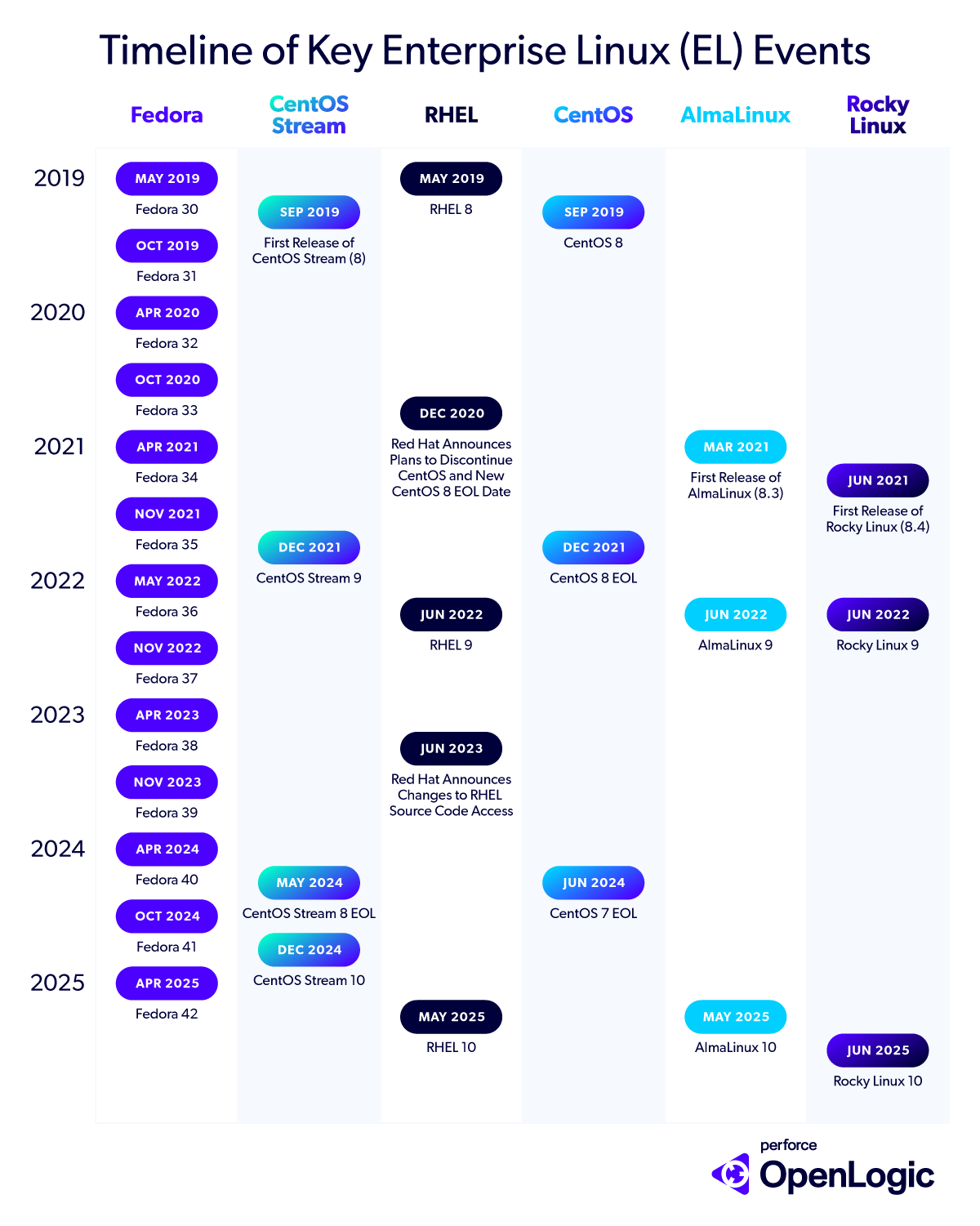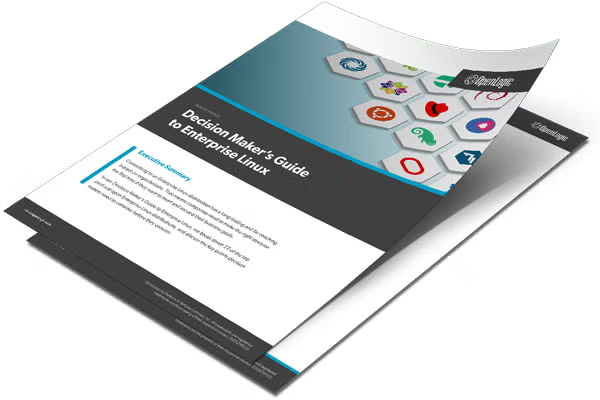The Definitive Guide For CentOS End of Life
As of June 30, 2024, all versions of CentOS Linux are end of life (EOL). If you’re currently on CentOS, you need to determine a support and migration strategy to avoid exposing your IT infrastructure (and business) to risk.
In this CentOS End of Life guide, we have compiled dozens of resources to help enterprise teams make informed decisions about how to move forward with minimal disruption. Whether you’re already in the process of planning your migration or need time to explore options, we want to make the transition as seamless as possible.
You can read along or jump to the section that interests you most:
CentOS Overview
Why Was CentOS So Popular?
CentOS Linux (not to be confused with CentOS Stream) gained a lot of popularity as a Linux distribution because it was an open source distribution derived from Red Hat Enterprise Linux (RHEL). Before it was discontinued in favor of CentOS Stream, the CentOS community was critical to the development and success of CentOS Linux distributions.
Many organizations — including large enterprises — choose free and open source Enterprise Linux distributions because they offer, freedom, flexibility, and cost-savings over expensive alternatives.
With that in mind, many teams that previously used CentOS are moving on to similar RHEL-derived distributions like Rocky Linux, AlmaLinux, or different flavors of Linux entirely.
Regardless of which Enterprise Linux distribution you choose, It’s always important to start by evaluating your open source strategy. Will you support your distro yourself? Or will you partner with a vendor for support? When backed by Enterprise Linux support, open source Enterprise Linux distributions can still offer superior security and stability to help your business deliver ROI and accelerate innovation.
Related Resources
Back to topAbout CentOS End of Life
The typical support lifecycle for CentOS versions was 10 years, during which the community would release 2-3 full updates per year for the first 6-7 years, followed by a phase of maintenance updates (only critical security and bug fixes) for the final 3-4 years.
However, on December 8, 2020, just a little over a year after the release of CentOS 8, Red Hat announced that CentOS 8 would be the last version and that the CentOS 8 EOL date was being moved up to December 2021, eight years ahead of schedule. This announcement came less than a month after CentOS 6 EOL happened on November 30, 2020.
The CentOS 7 EOL date (June 30, 2024) did not change.
Back to topWhen Was CentOS End of Life?
This table shows the release dates and community end of life dates for the last three versions of CentOS Linux:
| Version | Release Date | Community End of Life |
| CentOS 6 | July 10, 2011 | November 30, 2020 |
| CentOS 7 | July 7, 2014 | June 30, 2024 |
| CentOS 8 | September 24, 2019 | December 31, 2021 (moved up from 2029) |
Why Was CentOS Linux Discontinued?
As mentioned above, CentOS first emerged in 2004 and became extremely popular because of its robust features and stability. In 2010, nearly 30% of all web servers were running CentOS, making it the most used Enterprise Linux distribution, ahead of Debian. So what happened to CentOS?
Red Hat maintains that it decided to retire the CentOS project to prioritize and shift focus to its rolling distribution, CentOS Stream. The idea behind CentOS Stream is to provide a continuous stream of updates, fixes, and enhancements with builds available daily or every few days.
What Does CentOS EOL Mean For Users?
As of June 30, 2024, all versions of CentOS Linux are end-of-life, meaning that no more releases, bug fixes, or security patches will be put out by the community. CentOS deployments will be vulnerable to new CVEs that may be disclosed, and if not patched, servers running CentOS will be at risk for cyberattacks (data breaches, downtime, etc). Depending on the severity of the vulnerability, and scope and nature of the attack, this could be catastrophic for enterprises.
In final months of 2023 alone, two high-severity CVEs affecting Linux distributions including CentOS were disclosed: CVE 2023-4911 (“Looney Tunables”) and CVE 2023-4863. Both vulnerabilities required immediate attention to avoid malicious actors gaining unauthorized access and being able to negatively impact system performance.
Timeline of Enterprise Linux (EL) Events
This timeline shows major EL releases and other events impacting the Enterprise Linux landscape beginning with EL 8. Click on the image to enlarge.
 Back to top
Back to top
CentOS End of Life Considerations
Any time that software in your infrastructure reaches end of life, it’s important to assure internal stakeholders and customers that you have a plan. It’s also a good idea to be prepared to answer questions about the transition.
In this section, we’ll cover two areas likely to be top of mind for your organization after CentOS EOL: security (aka patches) and migration strategy.
Patching CentOS
Keeping software, especially business-critical software like your operating system, updated with patches can improve performance and security. Developing a patching protocol is a key step in open source lifecycle management and is highly recommended. It can help you prioritize patches and ensure testing happens before deploying in your production environment where there could be unexpected downstream effects on applications.
Learn more about patching CentOS >>
Find out in this video how How OpenLogic Builds CentOS Patches >>
Get best practices for keeping your Linux server secure >>
Planning Your Migration Off CentOS
Migrations don’t happen overnight; they require careful planning and extra resources. Depending on what CentOS version you're on and if you are planning an in-place migration, it may make sense to first upgrade CentOS using a tool like ELevate or LEAP.
Explore potential CentOS migration paths >>
Learn how to plan a successful Linux migration >>
Watch this video with CentOS 7 Migration Tips >>
Back to topUpdated: Decision Maker's Guide to Enterprise Linux
Download this white paper, revised in 2024, to compare the top open source Linux distributions viable for enterprise and get expert insights into how to select the right one for your organization.
Compatible Alternatives to CentOS
If you are comparing CentOS alternatives and trying to determine the best Linux distro for your organization, there are many things to consider. In this section, you’ll find links to resources related to the Enterprise Linux distributions that make the most sense as replacements for CentOS. Like CentOS, they are derived from RHEL, and are stable, established projects backed by active communities.
CentOS Stream
Because CentOS Stream was labeled the successor and new focus for the CentOS community, many assumed it would be similar to CentOS. In reality, the direction of the derivation has changed with CentOS Stream. CentOS Stream is now used as the staging ground for RHEL releases, and issues updates as "rolling releases.” This release structure can make it less of a fit for enterprises not equipped to handle continuous integration and deployment.
In June 2023, Red Hat announced that CentOS Stream would be the sole repository of RHEL source code and RHEL code would no longer be freely available to downstream rebuilds.
CentOS Stream Resources
- Blog - CentOS Stream 10 Overview
- Blog – CentOS Stream Migration Checklist
- Blog – CentOS Stream 9: What’s Next for CentOS Stream
- Webinar – Demystifying CentOS Stream
- Solution – CentOS Stream Support and Services
Rocky Linux
Rocky Linux was founded by Gregory Kurtzer, one of the architects of CentOS, and is one of the most popular CentOS alternatives. Backed by the Rocky Enterprise Software Foundation, Rocky Linux uses RHEL SRPMs for their upstream.
Rocky Linux Resources
- Blog – Rocky Linux 9 Release
- Blog – What’s New in Rocky Linux 9.1
- Blog – Planning a CentOS to Rocky Linux Migration
- Blog – Comparing Rocky Linux vs. RHEL
- Video – What’s Next for Rocky Linux
- Solution – Rocky Linux Support and Services
AlmaLinux
Following the announcement of the discontinuation of CentOS, AlmaLinux was the first RHEL derivative to come out with a GA build. AlmaLinux is binary compatible with RHEL and backed by the AlmaLinux OS Foundation.
AlmaLinux Resources
- Blog – What’s New in AlmaLinux 9
- Blog – All About AlmaLinux 9.1
- Blog – How to Plan a CentOS to AlmaLinux Migration
- Video – AlmaLinux Explains the Impact of Red Hat’s RHEL Code Restriction
- Solution – AlmaLinux Support and Services
Back to topOpenLogic is a sponsor of both the Rocky Enterprise Software Foundation and the AlmaLinux OS Foundation. For a head-to-head comparison of the two distros, check out our Rocky Linux vs. AlmaLinux blog.
Other Alternatives
None of these Linux distributions are directly compatible with CentOS and thus would require a total rebuild. Still, it could be a useful exercise to compare the features and functionality of these distros if you're going to be standing up a new system.
Ubuntu
Ubuntu packages are based on packages from Debian’s unstable branch, but are not necessarily binary compatible. Ubuntu tends to be more desktop-oriented than CentOS, and it's updated every six months, with a five-year support lifecycle.
Ubuntu Resources
- Blog – CentOS vs. Ubuntu
- Solution – Ubuntu Support
Debian
Debian and CentOS have many similarities, but there are some key differences in filesystems, package management, and supported architectures.
Debian Resources
- Blog – CentOS vs. Debian
- Solution – Debian Support
Fedora
Fedora is the bleeding edge upstream Enterprise Linux distribution. It has newer libraries, packages, and kernels, which make it a good testing ground, but it's not suitable for production since some of the software may not be stable.
Fedora Resources
- Blog – CentOS vs. Fedora
After CentOS End of Life: Support Options
If you need more time to plan your migration and don’t have the expertise in-house to patch CentOS, a third-party vendor like OpenLogic can bridge the support gap. In the on-demand webinar below, Perforce's Senior Director of Product Management Tzvika Shahaf and OpenLogic's Senior Solutions Engineer Sean Goodner talk about CentOS EOL and explain how long-term support (LTS) can help customers manage the transition smoothly.
CentOS End of Life Is Here: Plan Your Next Steps
Don't Gamble With EOL CentOS. Get Support Today.
OpenLogic offers both LTS and technical support for CentOS 6, 7, and 8. Partner with OpenLogic to extend your migration runway, maintain compliance, and get 24/7 technical support from real Linux experts while you plan your next steps.
After you migrate, OpenLogic can provide SLA-backed support for your new Linux distribution; click the button below to learn more.
Enterprise Linux Support and Services
